Report on Family, Friendship, and Their Impact on Happiness
VerifiedAdded on 2023/06/08
|20
|4172
|454
Report
AI Summary
This report explores the multifaceted relationship between family, friendship, and happiness, drawing upon existing literature and conducting a survey to gather quantitative data. The study employs a conceptual framework that posits family and friends as independent variables influencing the dependent variable of happiness. The methodology involves an online survey using the World Values Survey platform, with a focus on a sample of working individuals and families. Data analysis utilizes descriptive statistics, including frequency tables, graphs, and charts, along with statistical tests like Pearson correlation and multicollinearity tests. The results reveal a strong correlation between family experiences and friendship with individual happiness, supporting the hypotheses. The report also discusses the normality, linearity, and homoscedasticity assumptions, which were tested before data analysis. Findings suggest that both family and friends are perceived as crucial factors in achieving individual happiness, as indicated by the responses. The study also delves into different theories of happiness, such as objective list theory, hedonism, and desire theory, providing a comprehensive understanding of the topic.
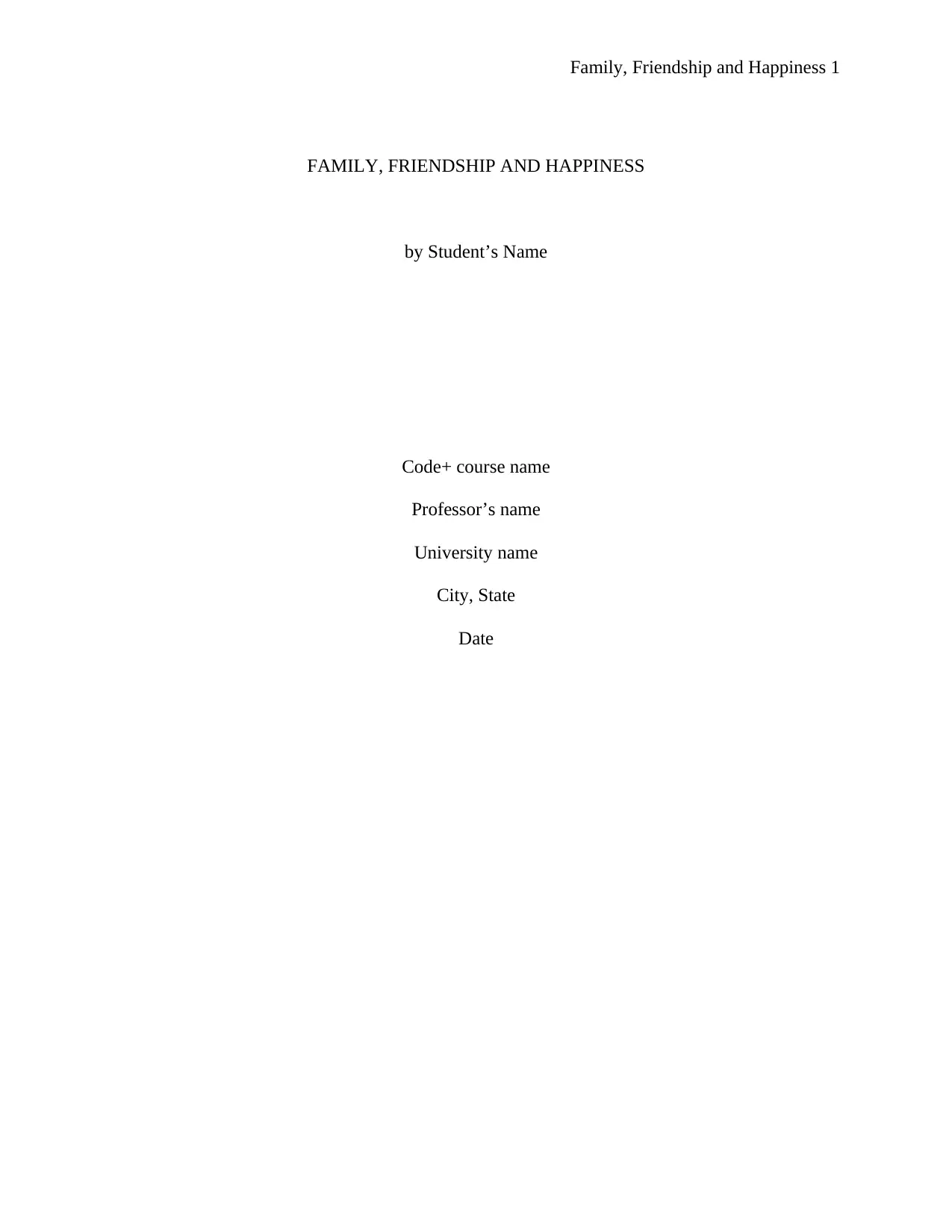
Family, Friendship and Happiness 1
FAMILY, FRIENDSHIP AND HAPPINESS
by Student’s Name
Code+ course name
Professor’s name
University name
City, State
Date
FAMILY, FRIENDSHIP AND HAPPINESS
by Student’s Name
Code+ course name
Professor’s name
University name
City, State
Date
Paraphrase This Document
Need a fresh take? Get an instant paraphrase of this document with our AI Paraphraser
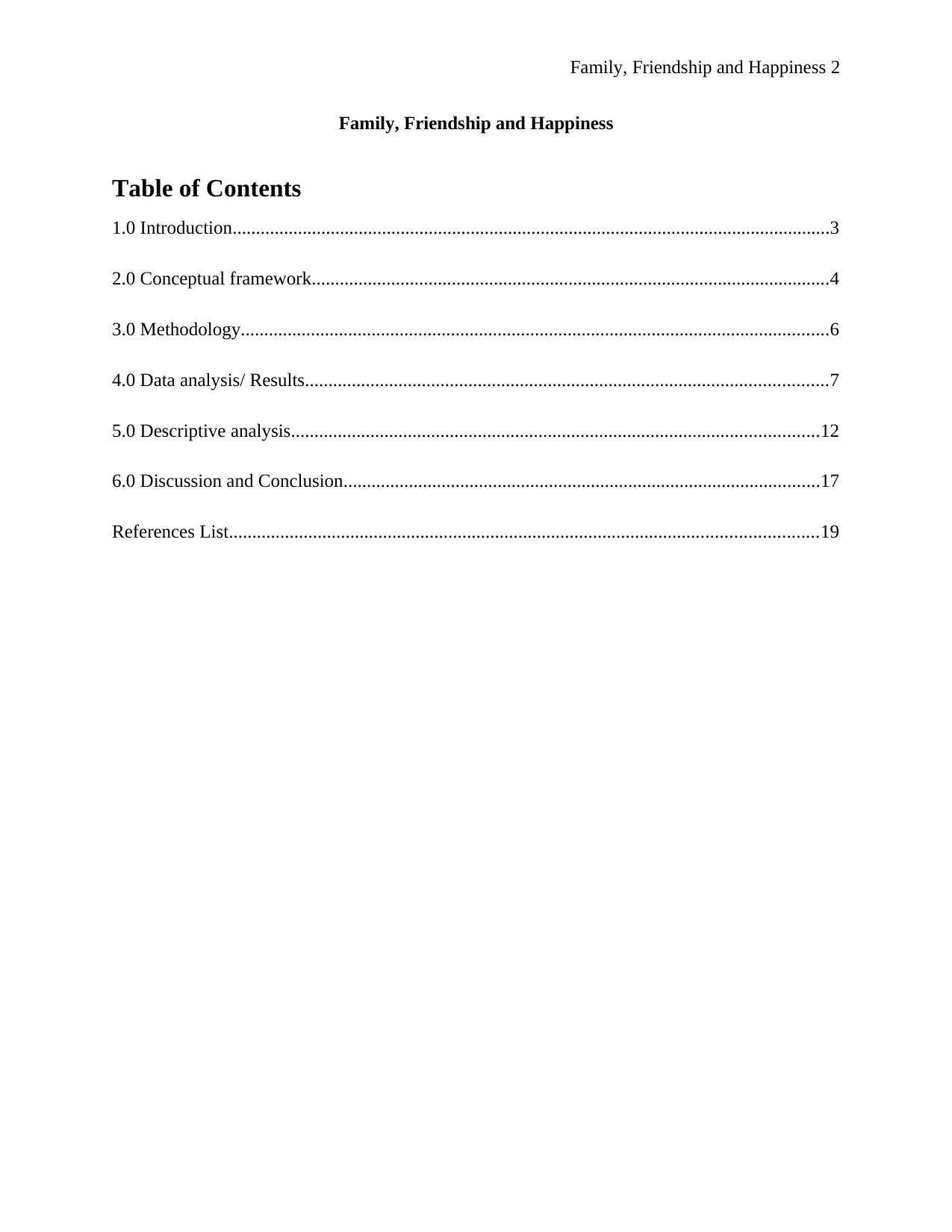
Family, Friendship and Happiness 2
Family, Friendship and Happiness
Table of Contents
1.0 Introduction................................................................................................................................3
2.0 Conceptual framework...............................................................................................................4
3.0 Methodology..............................................................................................................................6
4.0 Data analysis/ Results................................................................................................................7
5.0 Descriptive analysis.................................................................................................................12
6.0 Discussion and Conclusion......................................................................................................17
References List..............................................................................................................................19
Family, Friendship and Happiness
Table of Contents
1.0 Introduction................................................................................................................................3
2.0 Conceptual framework...............................................................................................................4
3.0 Methodology..............................................................................................................................6
4.0 Data analysis/ Results................................................................................................................7
5.0 Descriptive analysis.................................................................................................................12
6.0 Discussion and Conclusion......................................................................................................17
References List..............................................................................................................................19
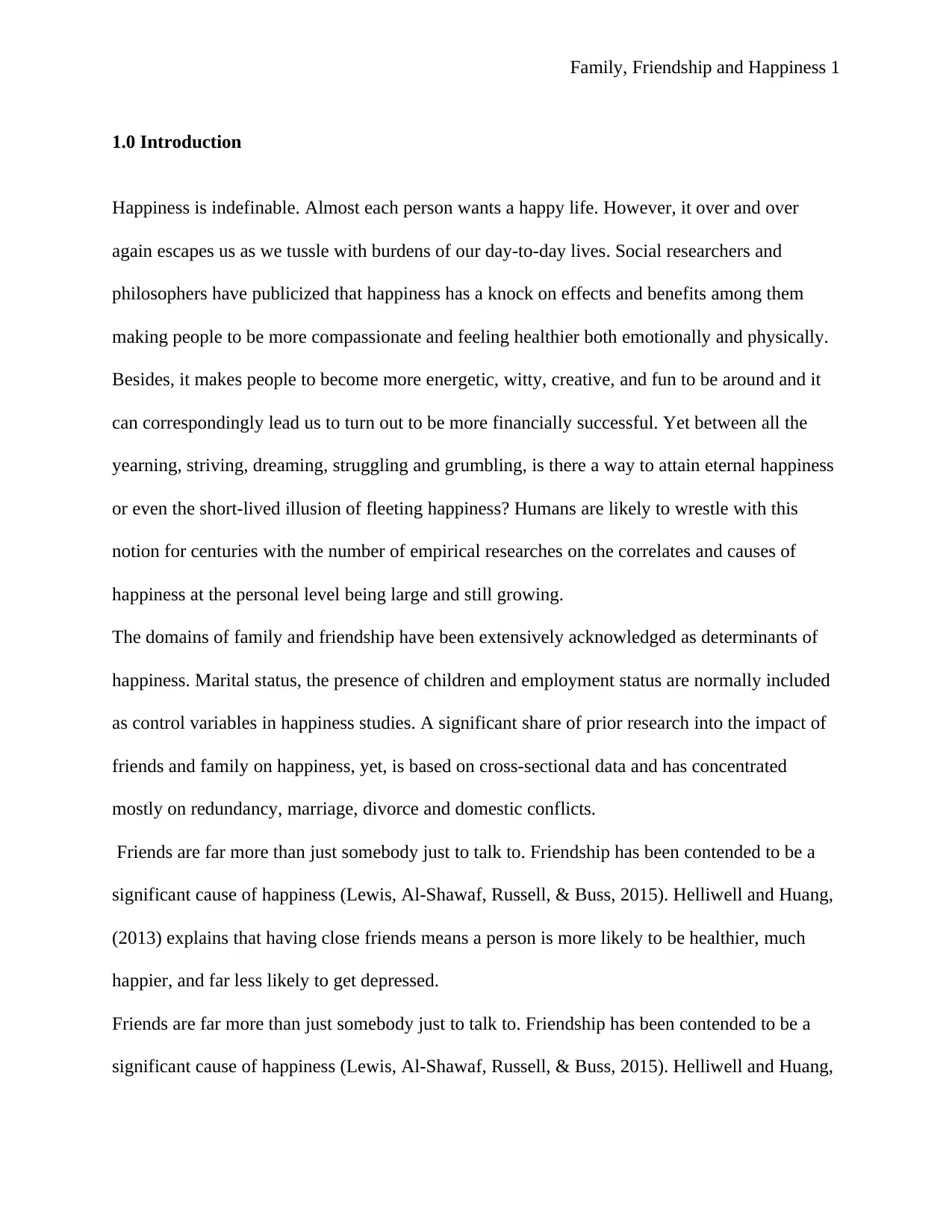
Family, Friendship and Happiness 1
1.0 Introduction
Happiness is indefinable. Almost each person wants a happy life. However, it over and over
again escapes us as we tussle with burdens of our day-to-day lives. Social researchers and
philosophers have publicized that happiness has a knock on effects and benefits among them
making people to be more compassionate and feeling healthier both emotionally and physically.
Besides, it makes people to become more energetic, witty, creative, and fun to be around and it
can correspondingly lead us to turn out to be more financially successful. Yet between all the
yearning, striving, dreaming, struggling and grumbling, is there a way to attain eternal happiness
or even the short-lived illusion of fleeting happiness? Humans are likely to wrestle with this
notion for centuries with the number of empirical researches on the correlates and causes of
happiness at the personal level being large and still growing.
The domains of family and friendship have been extensively acknowledged as determinants of
happiness. Marital status, the presence of children and employment status are normally included
as control variables in happiness studies. A significant share of prior research into the impact of
friends and family on happiness, yet, is based on cross-sectional data and has concentrated
mostly on redundancy, marriage, divorce and domestic conflicts.
Friends are far more than just somebody just to talk to. Friendship has been contended to be a
significant cause of happiness (Lewis, Al-Shawaf, Russell, & Buss, 2015). Helliwell and Huang,
(2013) explains that having close friends means a person is more likely to be healthier, much
happier, and far less likely to get depressed.
Friends are far more than just somebody just to talk to. Friendship has been contended to be a
significant cause of happiness (Lewis, Al-Shawaf, Russell, & Buss, 2015). Helliwell and Huang,
1.0 Introduction
Happiness is indefinable. Almost each person wants a happy life. However, it over and over
again escapes us as we tussle with burdens of our day-to-day lives. Social researchers and
philosophers have publicized that happiness has a knock on effects and benefits among them
making people to be more compassionate and feeling healthier both emotionally and physically.
Besides, it makes people to become more energetic, witty, creative, and fun to be around and it
can correspondingly lead us to turn out to be more financially successful. Yet between all the
yearning, striving, dreaming, struggling and grumbling, is there a way to attain eternal happiness
or even the short-lived illusion of fleeting happiness? Humans are likely to wrestle with this
notion for centuries with the number of empirical researches on the correlates and causes of
happiness at the personal level being large and still growing.
The domains of family and friendship have been extensively acknowledged as determinants of
happiness. Marital status, the presence of children and employment status are normally included
as control variables in happiness studies. A significant share of prior research into the impact of
friends and family on happiness, yet, is based on cross-sectional data and has concentrated
mostly on redundancy, marriage, divorce and domestic conflicts.
Friends are far more than just somebody just to talk to. Friendship has been contended to be a
significant cause of happiness (Lewis, Al-Shawaf, Russell, & Buss, 2015). Helliwell and Huang,
(2013) explains that having close friends means a person is more likely to be healthier, much
happier, and far less likely to get depressed.
Friends are far more than just somebody just to talk to. Friendship has been contended to be a
significant cause of happiness (Lewis, Al-Shawaf, Russell, & Buss, 2015). Helliwell and Huang,
⊘ This is a preview!⊘
Do you want full access?
Subscribe today to unlock all pages.

Trusted by 1+ million students worldwide
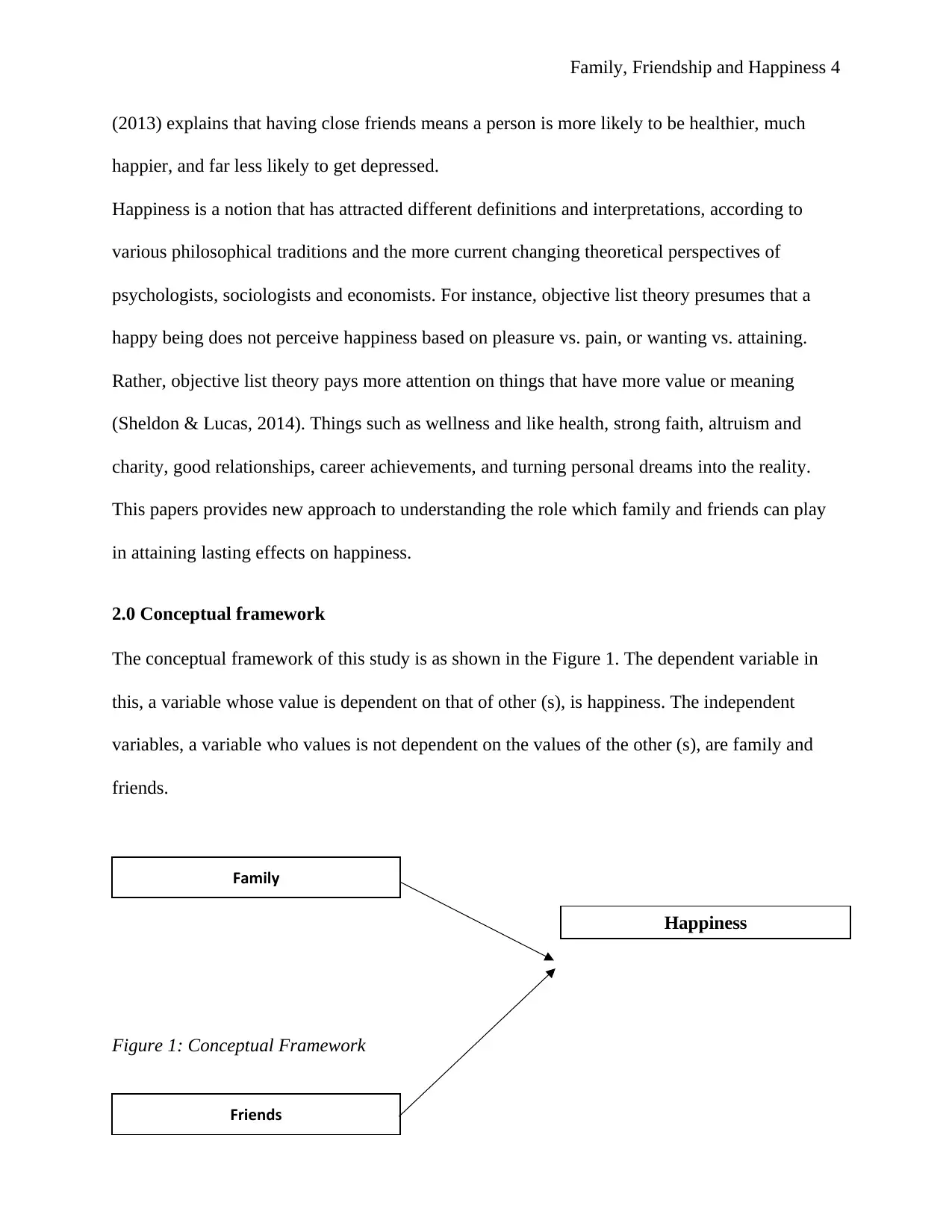
Family, Friendship and Happiness 4
(2013) explains that having close friends means a person is more likely to be healthier, much
happier, and far less likely to get depressed.
Happiness is a notion that has attracted different definitions and interpretations, according to
various philosophical traditions and the more current changing theoretical perspectives of
psychologists, sociologists and economists. For instance, objective list theory presumes that a
happy being does not perceive happiness based on pleasure vs. pain, or wanting vs. attaining.
Rather, objective list theory pays more attention on things that have more value or meaning
(Sheldon & Lucas, 2014). Things such as wellness and like health, strong faith, altruism and
charity, good relationships, career achievements, and turning personal dreams into the reality.
This papers provides new approach to understanding the role which family and friends can play
in attaining lasting effects on happiness.
2.0 Conceptual framework
The conceptual framework of this study is as shown in the Figure 1. The dependent variable in
this, a variable whose value is dependent on that of other (s), is happiness. The independent
variables, a variable who values is not dependent on the values of the other (s), are family and
friends.
Figure 1: Conceptual Framework
Happiness
Family
Friends
(2013) explains that having close friends means a person is more likely to be healthier, much
happier, and far less likely to get depressed.
Happiness is a notion that has attracted different definitions and interpretations, according to
various philosophical traditions and the more current changing theoretical perspectives of
psychologists, sociologists and economists. For instance, objective list theory presumes that a
happy being does not perceive happiness based on pleasure vs. pain, or wanting vs. attaining.
Rather, objective list theory pays more attention on things that have more value or meaning
(Sheldon & Lucas, 2014). Things such as wellness and like health, strong faith, altruism and
charity, good relationships, career achievements, and turning personal dreams into the reality.
This papers provides new approach to understanding the role which family and friends can play
in attaining lasting effects on happiness.
2.0 Conceptual framework
The conceptual framework of this study is as shown in the Figure 1. The dependent variable in
this, a variable whose value is dependent on that of other (s), is happiness. The independent
variables, a variable who values is not dependent on the values of the other (s), are family and
friends.
Figure 1: Conceptual Framework
Happiness
Family
Friends
Paraphrase This Document
Need a fresh take? Get an instant paraphrase of this document with our AI Paraphraser
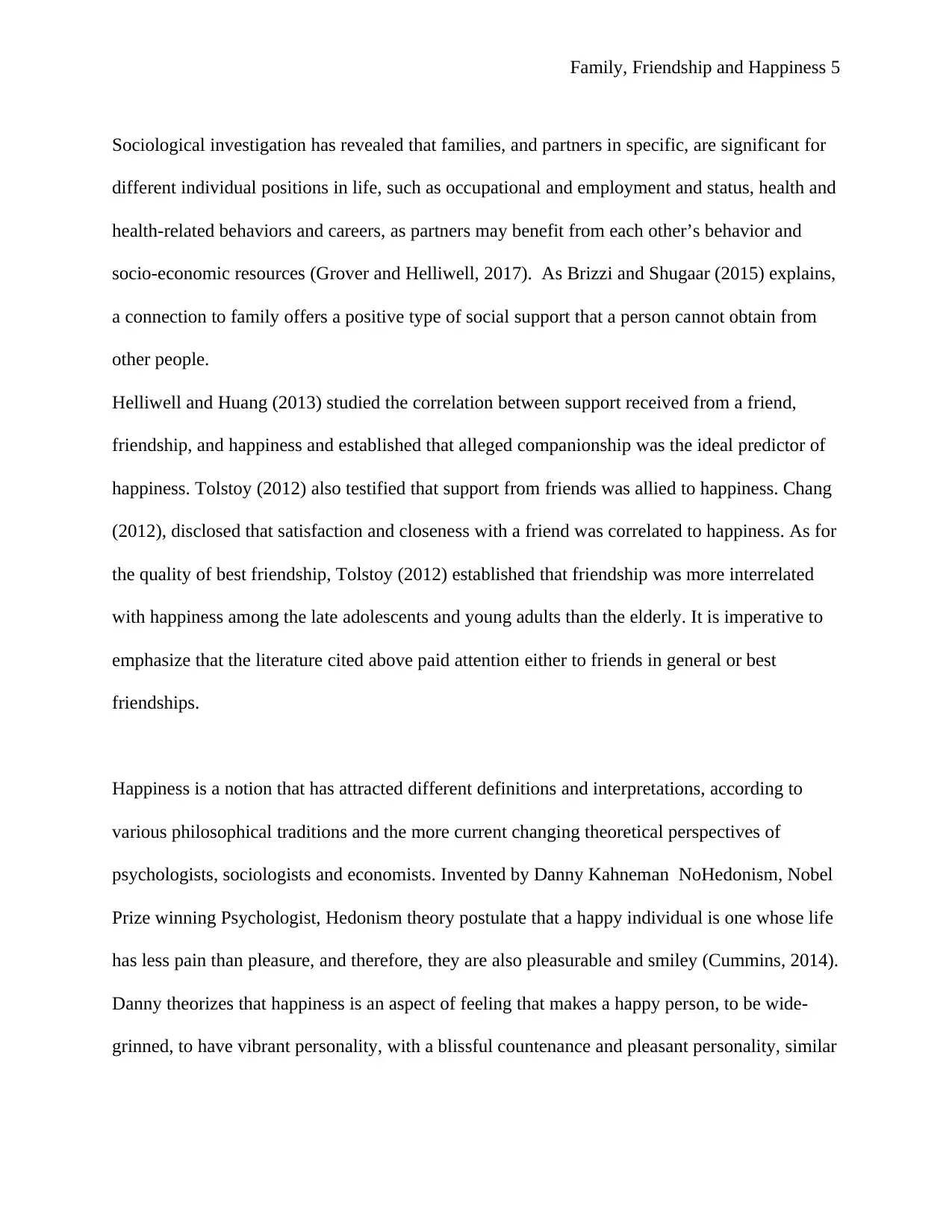
Family, Friendship and Happiness 5
Sociological investigation has revealed that families, and partners in specific, are significant for
different individual positions in life, such as occupational and employment and status, health and
health-related behaviors and careers, as partners may benefit from each other’s behavior and
socio-economic resources (Grover and Helliwell, 2017). As Brizzi and Shugaar (2015) explains,
a connection to family offers a positive type of social support that a person cannot obtain from
other people.
Helliwell and Huang (2013) studied the correlation between support received from a friend,
friendship, and happiness and established that alleged companionship was the ideal predictor of
happiness. Tolstoy (2012) also testified that support from friends was allied to happiness. Chang
(2012), disclosed that satisfaction and closeness with a friend was correlated to happiness. As for
the quality of best friendship, Tolstoy (2012) established that friendship was more interrelated
with happiness among the late adolescents and young adults than the elderly. It is imperative to
emphasize that the literature cited above paid attention either to friends in general or best
friendships.
Happiness is a notion that has attracted different definitions and interpretations, according to
various philosophical traditions and the more current changing theoretical perspectives of
psychologists, sociologists and economists. Invented by Danny Kahneman NoHedonism, Nobel
Prize winning Psychologist, Hedonism theory postulate that a happy individual is one whose life
has less pain than pleasure, and therefore, they are also pleasurable and smiley (Cummins, 2014).
Danny theorizes that happiness is an aspect of feeling that makes a happy person, to be wide-
grinned, to have vibrant personality, with a blissful countenance and pleasant personality, similar
Sociological investigation has revealed that families, and partners in specific, are significant for
different individual positions in life, such as occupational and employment and status, health and
health-related behaviors and careers, as partners may benefit from each other’s behavior and
socio-economic resources (Grover and Helliwell, 2017). As Brizzi and Shugaar (2015) explains,
a connection to family offers a positive type of social support that a person cannot obtain from
other people.
Helliwell and Huang (2013) studied the correlation between support received from a friend,
friendship, and happiness and established that alleged companionship was the ideal predictor of
happiness. Tolstoy (2012) also testified that support from friends was allied to happiness. Chang
(2012), disclosed that satisfaction and closeness with a friend was correlated to happiness. As for
the quality of best friendship, Tolstoy (2012) established that friendship was more interrelated
with happiness among the late adolescents and young adults than the elderly. It is imperative to
emphasize that the literature cited above paid attention either to friends in general or best
friendships.
Happiness is a notion that has attracted different definitions and interpretations, according to
various philosophical traditions and the more current changing theoretical perspectives of
psychologists, sociologists and economists. Invented by Danny Kahneman NoHedonism, Nobel
Prize winning Psychologist, Hedonism theory postulate that a happy individual is one whose life
has less pain than pleasure, and therefore, they are also pleasurable and smiley (Cummins, 2014).
Danny theorizes that happiness is an aspect of feeling that makes a happy person, to be wide-
grinned, to have vibrant personality, with a blissful countenance and pleasant personality, similar
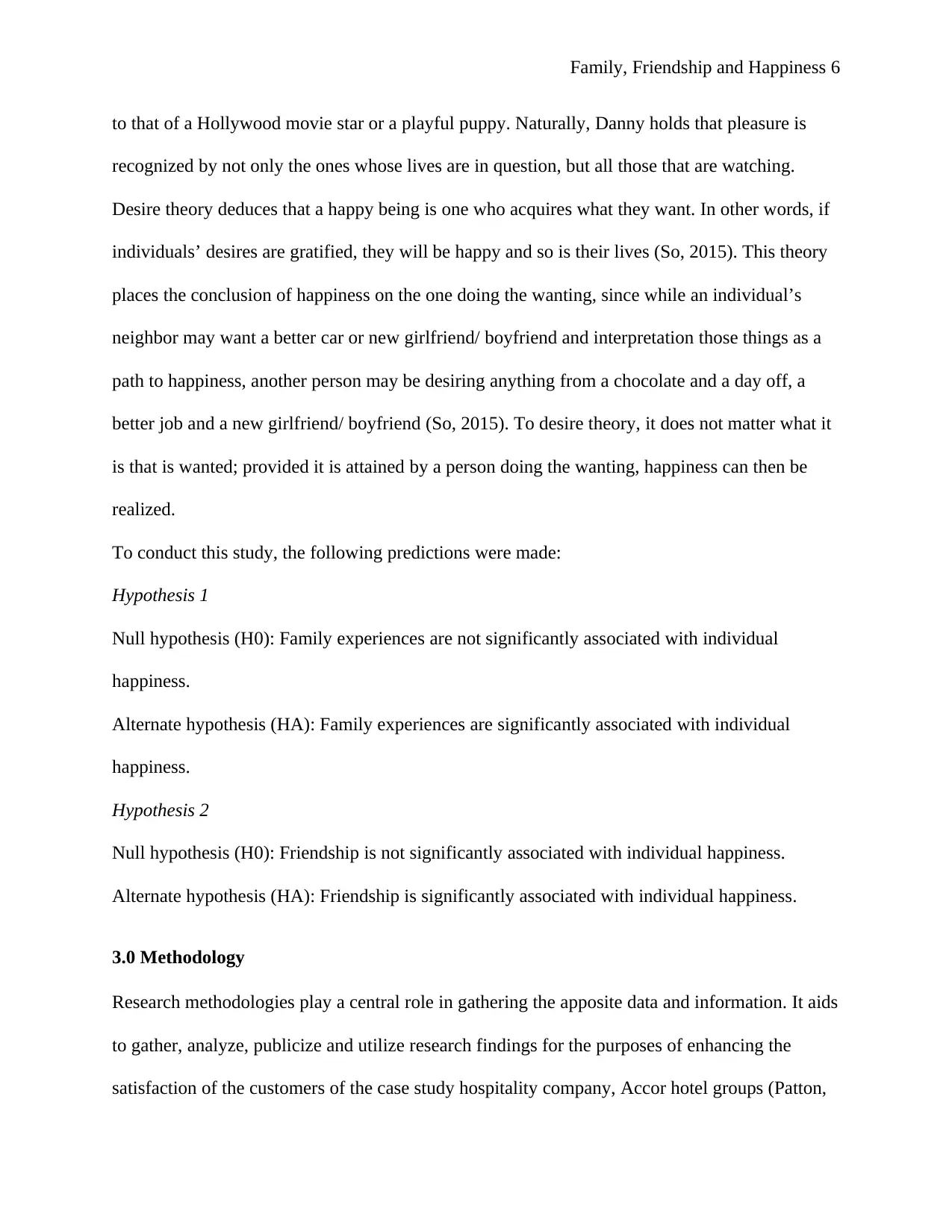
Family, Friendship and Happiness 6
to that of a Hollywood movie star or a playful puppy. Naturally, Danny holds that pleasure is
recognized by not only the ones whose lives are in question, but all those that are watching.
Desire theory deduces that a happy being is one who acquires what they want. In other words, if
individuals’ desires are gratified, they will be happy and so is their lives (So, 2015). This theory
places the conclusion of happiness on the one doing the wanting, since while an individual’s
neighbor may want a better car or new girlfriend/ boyfriend and interpretation those things as a
path to happiness, another person may be desiring anything from a chocolate and a day off, a
better job and a new girlfriend/ boyfriend (So, 2015). To desire theory, it does not matter what it
is that is wanted; provided it is attained by a person doing the wanting, happiness can then be
realized.
To conduct this study, the following predictions were made:
Hypothesis 1
Null hypothesis (H0): Family experiences are not significantly associated with individual
happiness.
Alternate hypothesis (HA): Family experiences are significantly associated with individual
happiness.
Hypothesis 2
Null hypothesis (H0): Friendship is not significantly associated with individual happiness.
Alternate hypothesis (HA): Friendship is significantly associated with individual happiness.
3.0 Methodology
Research methodologies play a central role in gathering the apposite data and information. It aids
to gather, analyze, publicize and utilize research findings for the purposes of enhancing the
satisfaction of the customers of the case study hospitality company, Accor hotel groups (Patton,
to that of a Hollywood movie star or a playful puppy. Naturally, Danny holds that pleasure is
recognized by not only the ones whose lives are in question, but all those that are watching.
Desire theory deduces that a happy being is one who acquires what they want. In other words, if
individuals’ desires are gratified, they will be happy and so is their lives (So, 2015). This theory
places the conclusion of happiness on the one doing the wanting, since while an individual’s
neighbor may want a better car or new girlfriend/ boyfriend and interpretation those things as a
path to happiness, another person may be desiring anything from a chocolate and a day off, a
better job and a new girlfriend/ boyfriend (So, 2015). To desire theory, it does not matter what it
is that is wanted; provided it is attained by a person doing the wanting, happiness can then be
realized.
To conduct this study, the following predictions were made:
Hypothesis 1
Null hypothesis (H0): Family experiences are not significantly associated with individual
happiness.
Alternate hypothesis (HA): Family experiences are significantly associated with individual
happiness.
Hypothesis 2
Null hypothesis (H0): Friendship is not significantly associated with individual happiness.
Alternate hypothesis (HA): Friendship is significantly associated with individual happiness.
3.0 Methodology
Research methodologies play a central role in gathering the apposite data and information. It aids
to gather, analyze, publicize and utilize research findings for the purposes of enhancing the
satisfaction of the customers of the case study hospitality company, Accor hotel groups (Patton,
⊘ This is a preview!⊘
Do you want full access?
Subscribe today to unlock all pages.

Trusted by 1+ million students worldwide
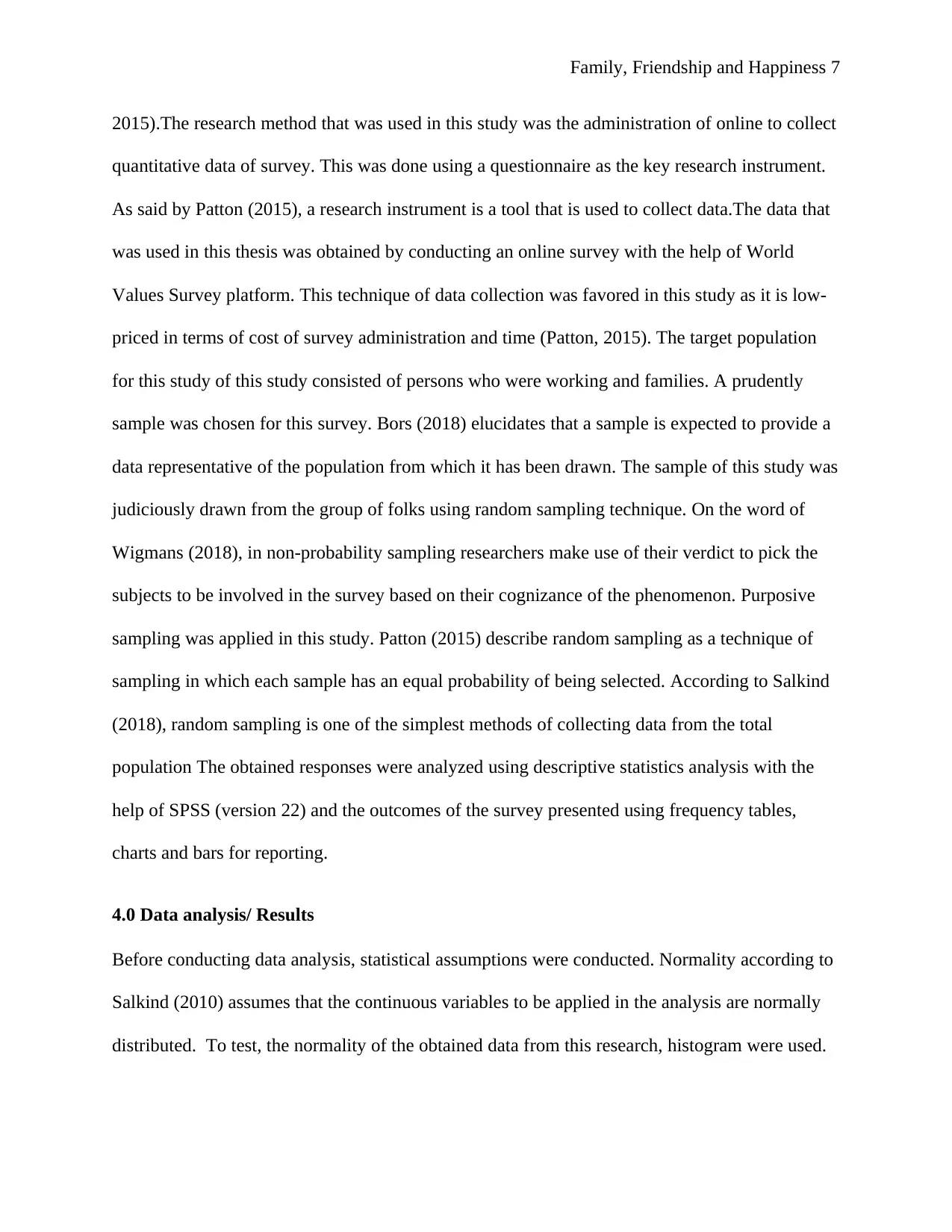
Family, Friendship and Happiness 7
2015).The research method that was used in this study was the administration of online to collect
quantitative data of survey. This was done using a questionnaire as the key research instrument.
As said by Patton (2015), a research instrument is a tool that is used to collect data.The data that
was used in this thesis was obtained by conducting an online survey with the help of World
Values Survey platform. This technique of data collection was favored in this study as it is low-
priced in terms of cost of survey administration and time (Patton, 2015). The target population
for this study of this study consisted of persons who were working and families. A prudently
sample was chosen for this survey. Bors (2018) elucidates that a sample is expected to provide a
data representative of the population from which it has been drawn. The sample of this study was
judiciously drawn from the group of folks using random sampling technique. On the word of
Wigmans (2018), in non-probability sampling researchers make use of their verdict to pick the
subjects to be involved in the survey based on their cognizance of the phenomenon. Purposive
sampling was applied in this study. Patton (2015) describe random sampling as a technique of
sampling in which each sample has an equal probability of being selected. According to Salkind
(2018), random sampling is one of the simplest methods of collecting data from the total
population The obtained responses were analyzed using descriptive statistics analysis with the
help of SPSS (version 22) and the outcomes of the survey presented using frequency tables,
charts and bars for reporting.
4.0 Data analysis/ Results
Before conducting data analysis, statistical assumptions were conducted. Normality according to
Salkind (2010) assumes that the continuous variables to be applied in the analysis are normally
distributed. To test, the normality of the obtained data from this research, histogram were used.
2015).The research method that was used in this study was the administration of online to collect
quantitative data of survey. This was done using a questionnaire as the key research instrument.
As said by Patton (2015), a research instrument is a tool that is used to collect data.The data that
was used in this thesis was obtained by conducting an online survey with the help of World
Values Survey platform. This technique of data collection was favored in this study as it is low-
priced in terms of cost of survey administration and time (Patton, 2015). The target population
for this study of this study consisted of persons who were working and families. A prudently
sample was chosen for this survey. Bors (2018) elucidates that a sample is expected to provide a
data representative of the population from which it has been drawn. The sample of this study was
judiciously drawn from the group of folks using random sampling technique. On the word of
Wigmans (2018), in non-probability sampling researchers make use of their verdict to pick the
subjects to be involved in the survey based on their cognizance of the phenomenon. Purposive
sampling was applied in this study. Patton (2015) describe random sampling as a technique of
sampling in which each sample has an equal probability of being selected. According to Salkind
(2018), random sampling is one of the simplest methods of collecting data from the total
population The obtained responses were analyzed using descriptive statistics analysis with the
help of SPSS (version 22) and the outcomes of the survey presented using frequency tables,
charts and bars for reporting.
4.0 Data analysis/ Results
Before conducting data analysis, statistical assumptions were conducted. Normality according to
Salkind (2010) assumes that the continuous variables to be applied in the analysis are normally
distributed. To test, the normality of the obtained data from this research, histogram were used.
Paraphrase This Document
Need a fresh take? Get an instant paraphrase of this document with our AI Paraphraser
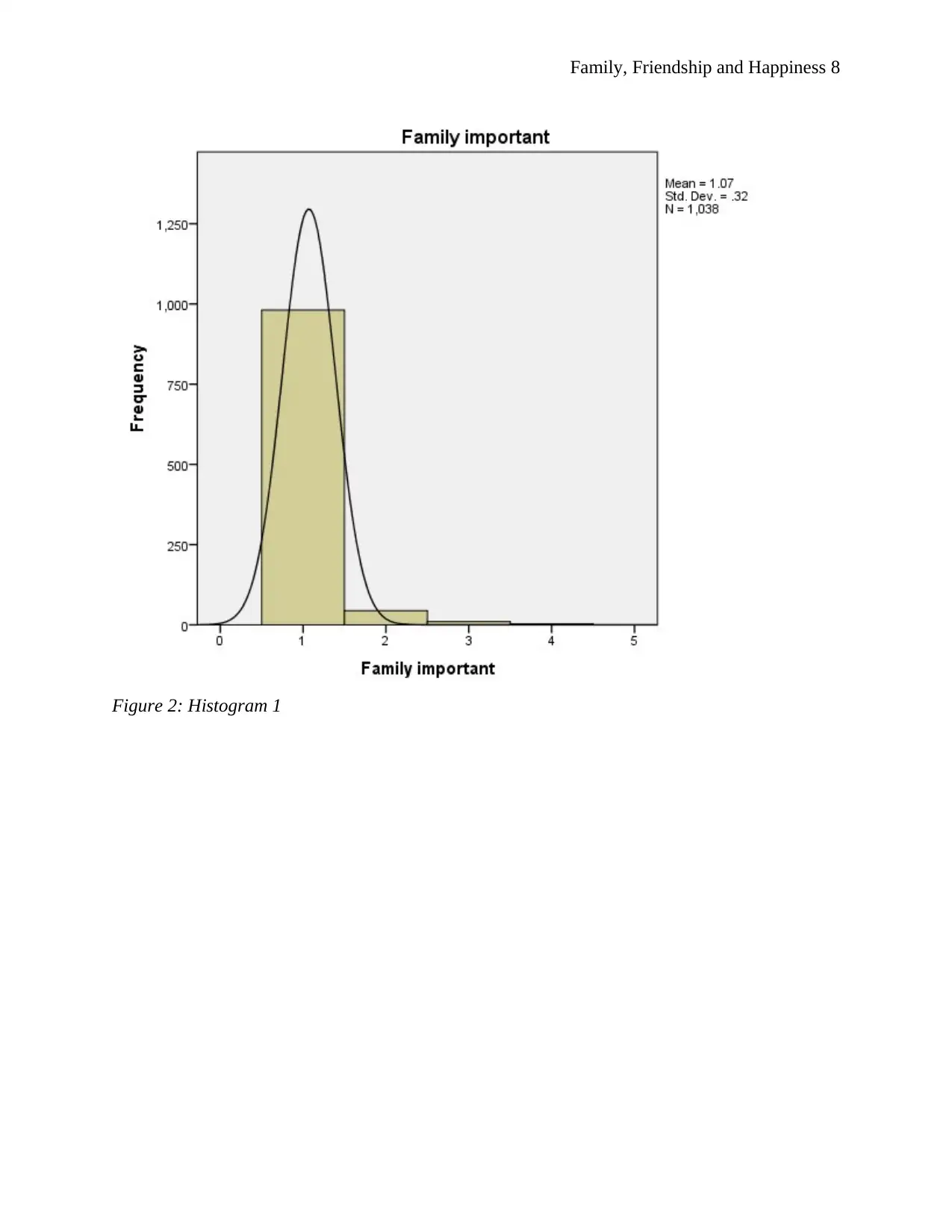
Family, Friendship and Happiness 8
Figure 2: Histogram 1
Figure 2: Histogram 1
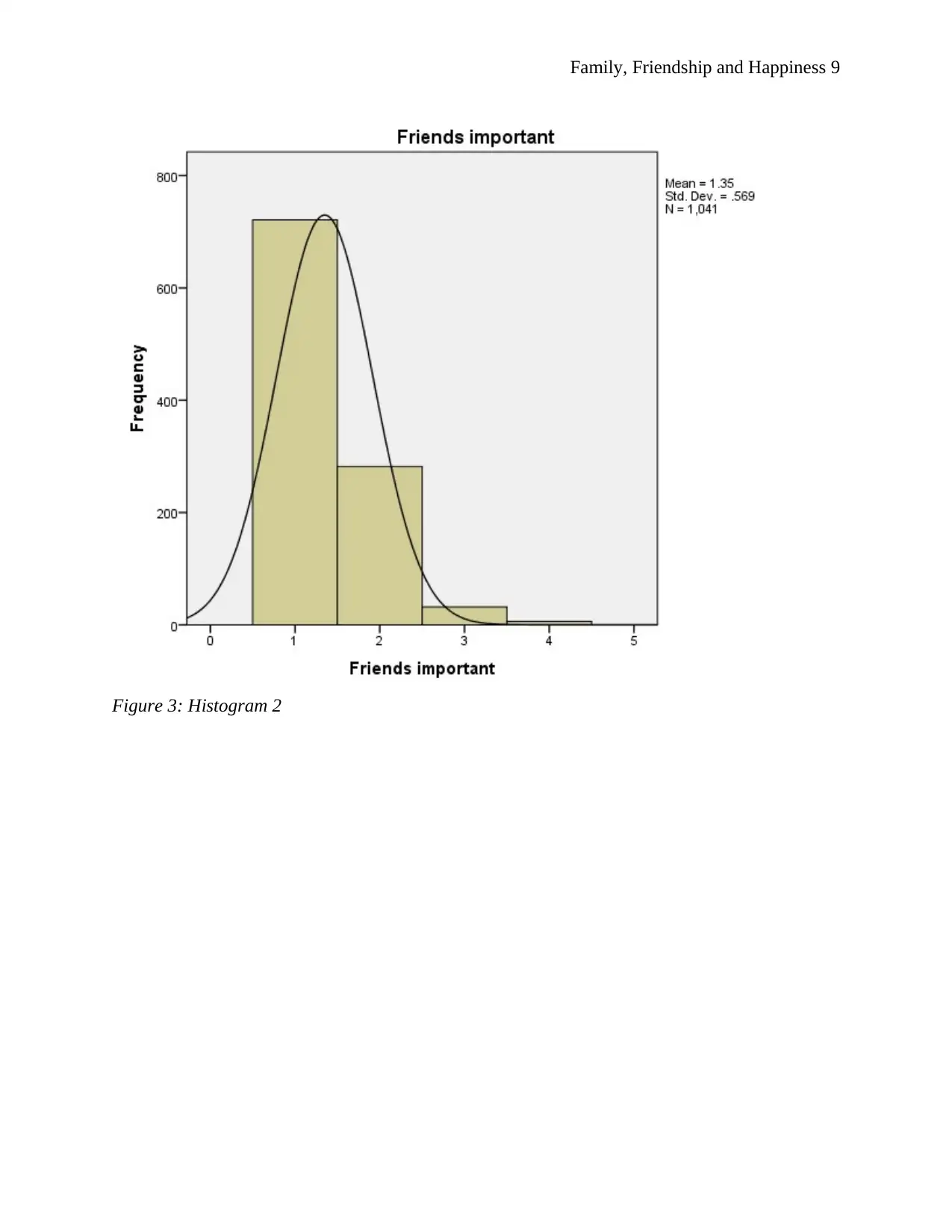
Family, Friendship and Happiness 9
Figure 3: Histogram 2
Figure 3: Histogram 2
⊘ This is a preview!⊘
Do you want full access?
Subscribe today to unlock all pages.

Trusted by 1+ million students worldwide
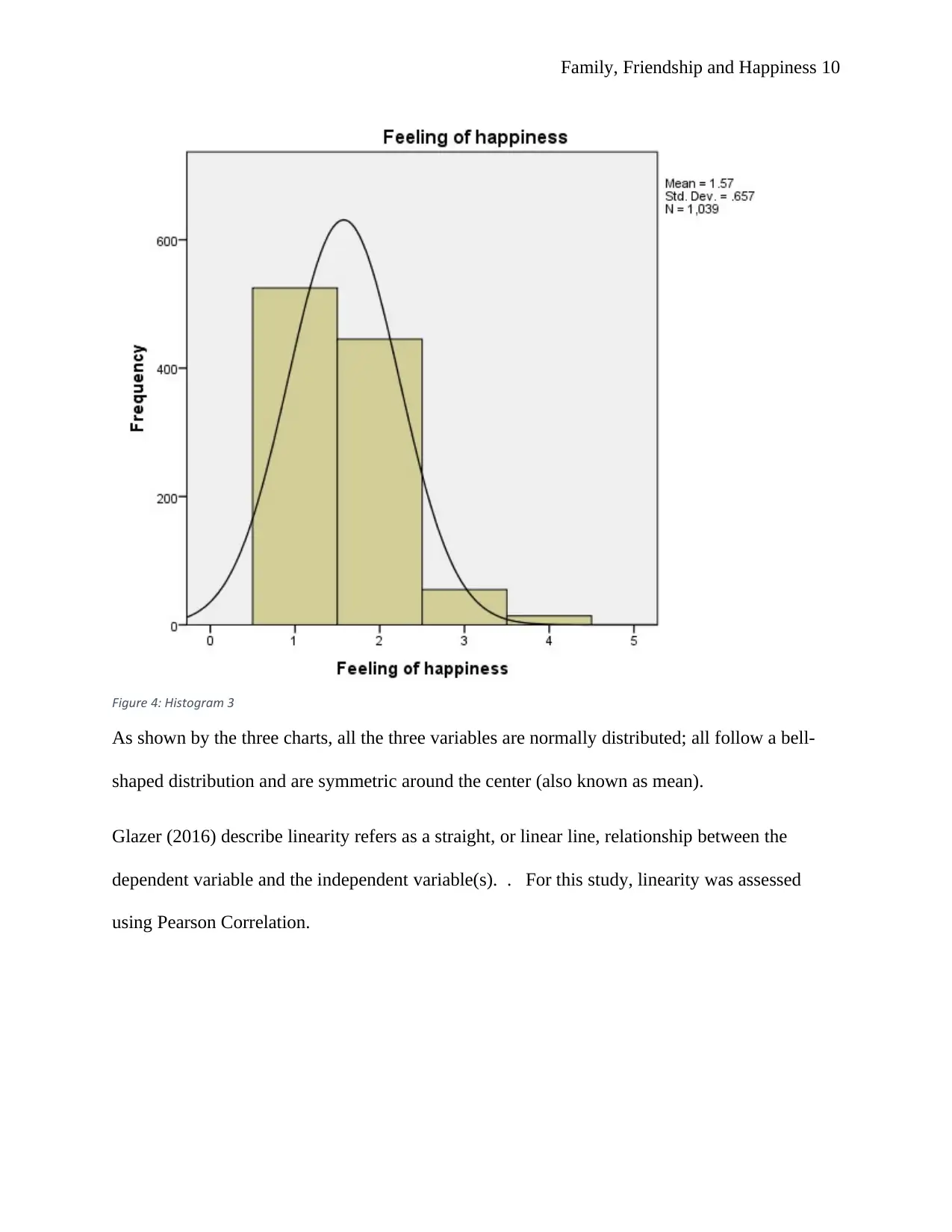
Family, Friendship and Happiness 10
Figure 4: Histogram 3
As shown by the three charts, all the three variables are normally distributed; all follow a bell-
shaped distribution and are symmetric around the center (also known as mean).
Glazer (2016) describe linearity refers as a straight, or linear line, relationship between the
dependent variable and the independent variable(s). . For this study, linearity was assessed
using Pearson Correlation.
Figure 4: Histogram 3
As shown by the three charts, all the three variables are normally distributed; all follow a bell-
shaped distribution and are symmetric around the center (also known as mean).
Glazer (2016) describe linearity refers as a straight, or linear line, relationship between the
dependent variable and the independent variable(s). . For this study, linearity was assessed
using Pearson Correlation.
Paraphrase This Document
Need a fresh take? Get an instant paraphrase of this document with our AI Paraphraser
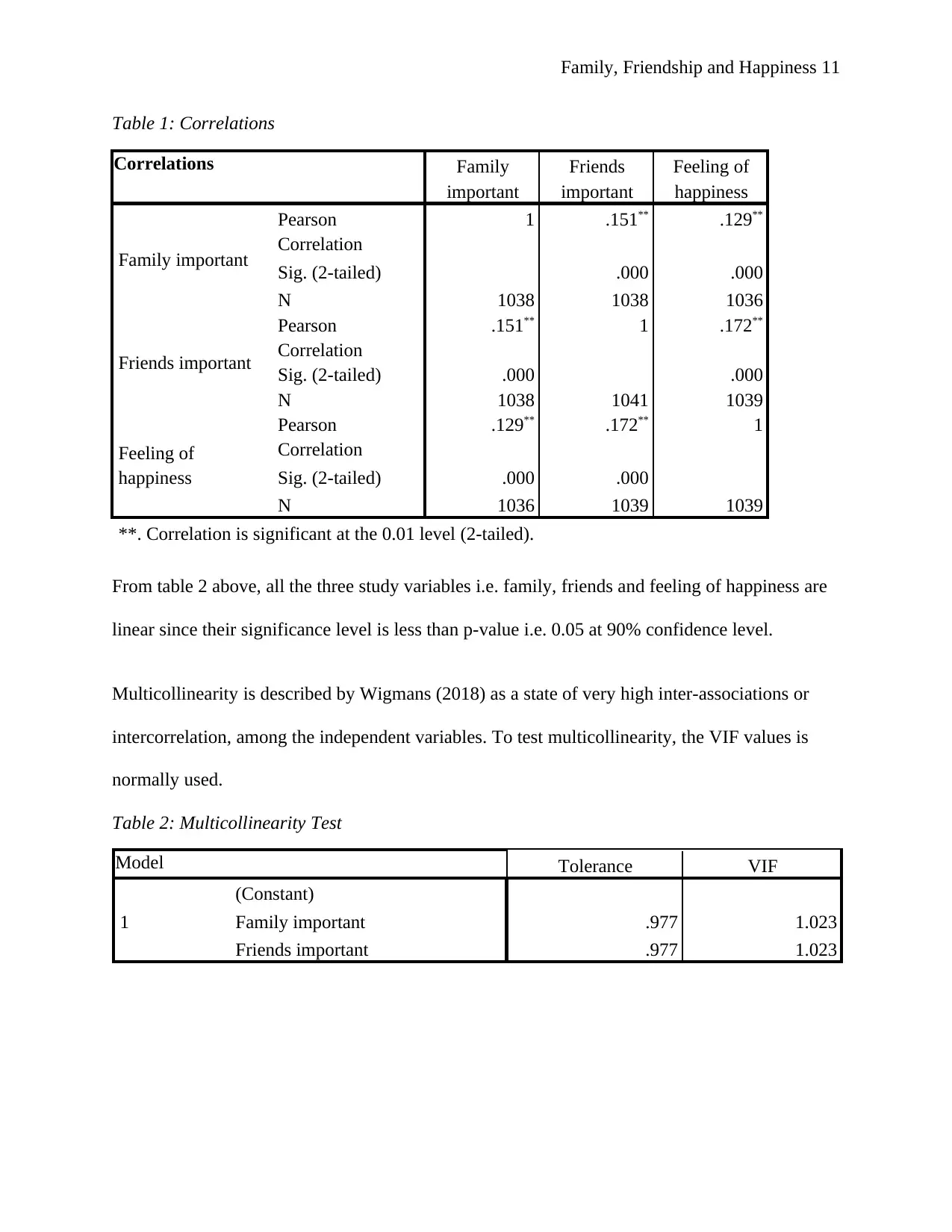
Family, Friendship and Happiness 11
Table 1: Correlations
Correlations Family
important
Friends
important
Feeling of
happiness
Family important
Pearson
Correlation
1 .151** .129**
Sig. (2-tailed) .000 .000
N 1038 1038 1036
Friends important
Pearson
Correlation
.151** 1 .172**
Sig. (2-tailed) .000 .000
N 1038 1041 1039
Feeling of
happiness
Pearson
Correlation
.129** .172** 1
Sig. (2-tailed) .000 .000
N 1036 1039 1039
**. Correlation is significant at the 0.01 level (2-tailed).
From table 2 above, all the three study variables i.e. family, friends and feeling of happiness are
linear since their significance level is less than p-value i.e. 0.05 at 90% confidence level.
Multicollinearity is described by Wigmans (2018) as a state of very high inter-associations or
intercorrelation, among the independent variables. To test multicollinearity, the VIF values is
normally used.
Table 2: Multicollinearity Test
Model Tolerance VIF
1
(Constant)
Family important .977 1.023
Friends important .977 1.023
Table 1: Correlations
Correlations Family
important
Friends
important
Feeling of
happiness
Family important
Pearson
Correlation
1 .151** .129**
Sig. (2-tailed) .000 .000
N 1038 1038 1036
Friends important
Pearson
Correlation
.151** 1 .172**
Sig. (2-tailed) .000 .000
N 1038 1041 1039
Feeling of
happiness
Pearson
Correlation
.129** .172** 1
Sig. (2-tailed) .000 .000
N 1036 1039 1039
**. Correlation is significant at the 0.01 level (2-tailed).
From table 2 above, all the three study variables i.e. family, friends and feeling of happiness are
linear since their significance level is less than p-value i.e. 0.05 at 90% confidence level.
Multicollinearity is described by Wigmans (2018) as a state of very high inter-associations or
intercorrelation, among the independent variables. To test multicollinearity, the VIF values is
normally used.
Table 2: Multicollinearity Test
Model Tolerance VIF
1
(Constant)
Family important .977 1.023
Friends important .977 1.023
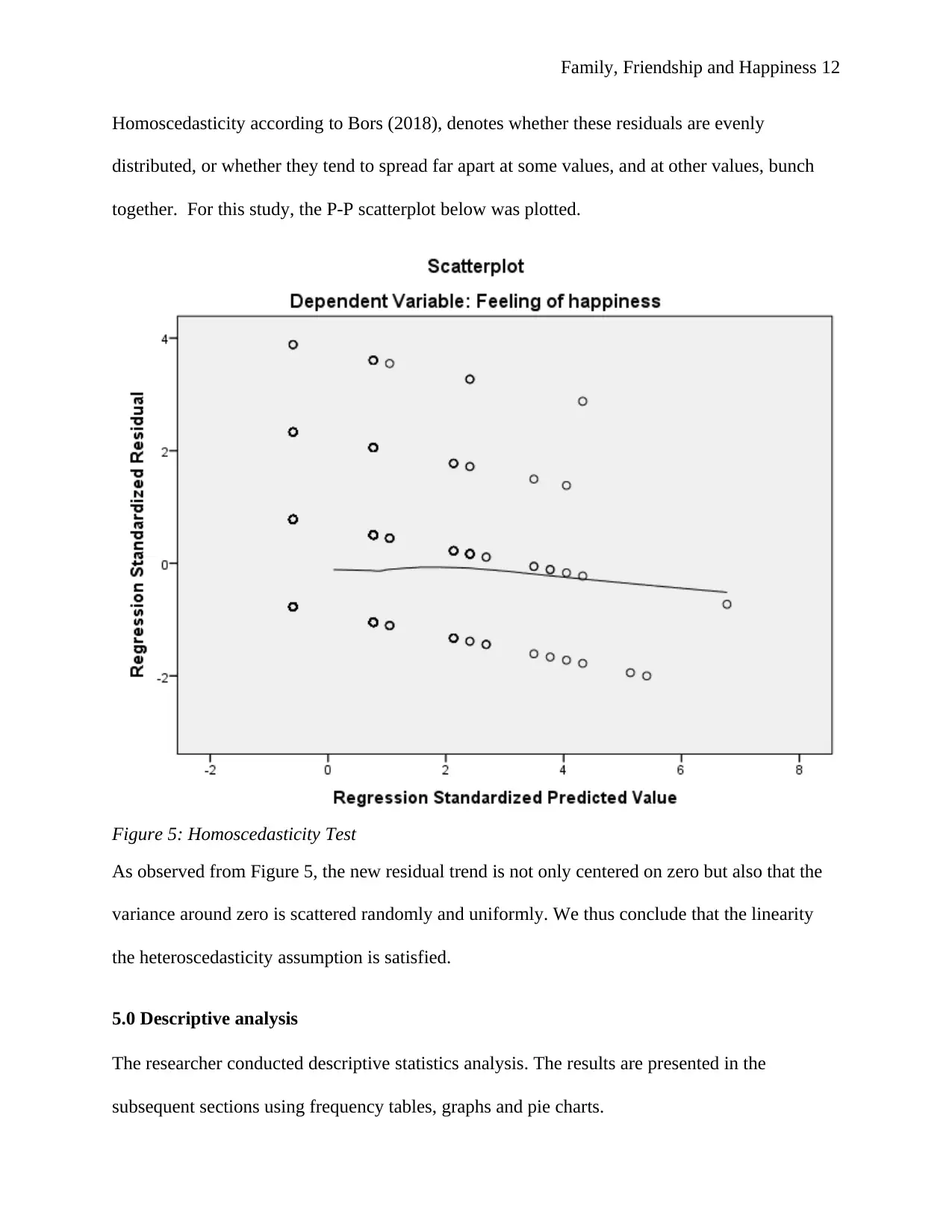
Family, Friendship and Happiness 12
Homoscedasticity according to Bors (2018), denotes whether these residuals are evenly
distributed, or whether they tend to spread far apart at some values, and at other values, bunch
together. For this study, the P-P scatterplot below was plotted.
Figure 5: Homoscedasticity Test
As observed from Figure 5, the new residual trend is not only centered on zero but also that the
variance around zero is scattered randomly and uniformly. We thus conclude that the linearity
the heteroscedasticity assumption is satisfied.
5.0 Descriptive analysis
The researcher conducted descriptive statistics analysis. The results are presented in the
subsequent sections using frequency tables, graphs and pie charts.
Homoscedasticity according to Bors (2018), denotes whether these residuals are evenly
distributed, or whether they tend to spread far apart at some values, and at other values, bunch
together. For this study, the P-P scatterplot below was plotted.
Figure 5: Homoscedasticity Test
As observed from Figure 5, the new residual trend is not only centered on zero but also that the
variance around zero is scattered randomly and uniformly. We thus conclude that the linearity
the heteroscedasticity assumption is satisfied.
5.0 Descriptive analysis
The researcher conducted descriptive statistics analysis. The results are presented in the
subsequent sections using frequency tables, graphs and pie charts.
⊘ This is a preview!⊘
Do you want full access?
Subscribe today to unlock all pages.

Trusted by 1+ million students worldwide
1 out of 20
Your All-in-One AI-Powered Toolkit for Academic Success.
+13062052269
info@desklib.com
Available 24*7 on WhatsApp / Email
![[object Object]](/_next/static/media/star-bottom.7253800d.svg)
Unlock your academic potential
Copyright © 2020–2025 A2Z Services. All Rights Reserved. Developed and managed by ZUCOL.